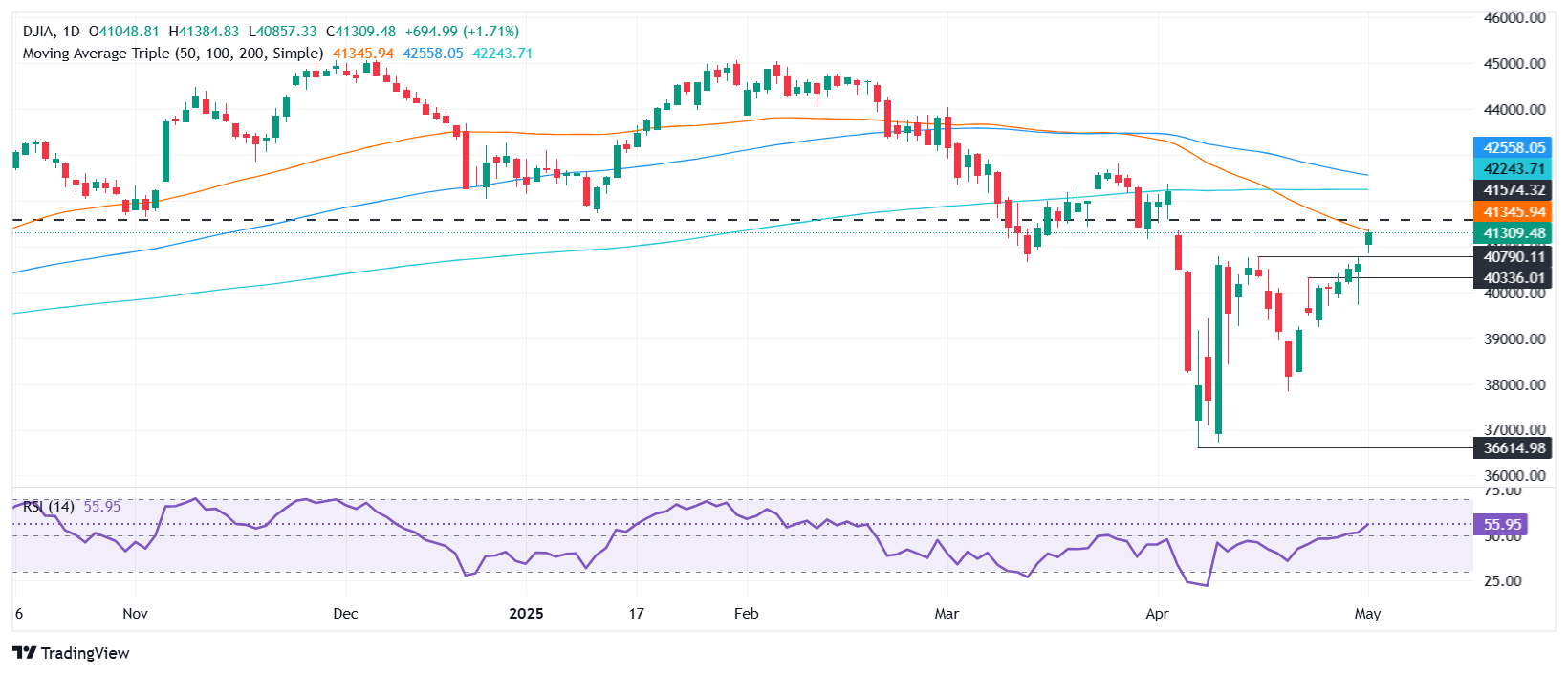Created
: 2025.05.03














![]() 2025.05.03 02:31
2025.05.03 02:31
The Dow Jones Industrial Average (DJIA) rallied over 600 points, or over 1.65%, on Friday following a solid US jobs report that brushed aside fears that the largest economy in the world is tied into a recession. The Dow is set to end the week with gains of over 3% and, at the time of writing, hovers past the 41,300 mark after rebounding off the daily low of 40,658.
US Nonfarm Payrolls in April increased by 177K, down from the downwardly revised number of 185K in March, but exceeding estimates of 130K. Earlier in the week, a dismal ADP National Employment Change report suggested that companies were hiring fewer people than the NFP revealed.
Also, the Unemployment Rate remained unchanged at 4.2%, aligned with forecasts, which might prevent the Federal Reserve (Fed) from easing policy.
Karen Georges, an equity fund manager at Ecofi in Paris, said, "These good numbers are not likely to fuel inflation, but this is no game changer for the Federal Reserve and Jerome Powell."
US President Donald Trump took advantage of the good figures and slammed Fed Chair Jerome Powell in a post on his Truth Social network, demanding the Fed lower interest rates.
US Factory Orders in March rose by 4.3% MoM, up from 0.5% the previous month but slightly below the 4.5% foreseen.
In the meantime, Apple (APPL) and Amazon (AMZN) shares are down 3.5% and 1%, respectively, with the former hit by a miss in sales in China and concern over tariffs. Apple revealed its earnings for Q1 2025, with earnings per share (EPS) coming at $1.65, above estimates of $1.62, and revenue of $95.36 billion, up from the $94.53 billion expected.
Amazon's stock edged down as cloud revenue growth disappointed. In its earnings report for Q1 2025, EPS rose to $1.59, up from the $1.38 forecast, and revenue increased by $155.7 billion above forecasts of $154.88.
Data from the Chicago Board of Trade (CBOT) shows the swaps market expects 88 basis points of easing toward the end of the year, as revealed by the December 2025 fed funds rate futures contract.
The Dow Jones remains downwardly biased, though traders are testing the 50-day Simple Moving Average (SMA) at 41,271. A daily close above the latter could extend the recovery past the 42,000 figure, with bulls targeting the 200-day SMA at 42,281.
Conversely, if the Dow tumbles below 41,000, the first support would be the 40,000 mark ahead of the 20-day SMA of 39,705. Once cleared the next support would be the April 23 low of 39,486, ahead of the April 22 high of 39,271 that would close the gap witnessed between April 22 and 23.

The Dow Jones Industrial Average, one of the oldest stock market indices in the world, is compiled of the 30 most traded stocks in the US. The index is price-weighted rather than weighted by capitalization. It is calculated by summing the prices of the constituent stocks and dividing them by a factor, currently 0.152. The index was founded by Charles Dow, who also founded the Wall Street Journal. In later years it has been criticized for not being broadly representative enough because it only tracks 30 conglomerates, unlike broader indices such as the S&P 500.
Many different factors drive the Dow Jones Industrial Average (DJIA). The aggregate performance of the component companies revealed in quarterly company earnings reports is the main one. US and global macroeconomic data also contributes as it impacts on investor sentiment. The level of interest rates, set by the Federal Reserve (Fed), also influences the DJIA as it affects the cost of credit, on which many corporations are heavily reliant. Therefore, inflation can be a major driver as well as other metrics which impact the Fed decisions.
Dow Theory is a method for identifying the primary trend of the stock market developed by Charles Dow. A key step is to compare the direction of the Dow Jones Industrial Average (DJIA) and the Dow Jones Transportation Average (DJTA) and only follow trends where both are moving in the same direction. Volume is a confirmatory criteria. The theory uses elements of peak and trough analysis. Dow's theory posits three trend phases: accumulation, when smart money starts buying or selling; public participation, when the wider public joins in; and distribution, when the smart money exits.
There are a number of ways to trade the DJIA. One is to use ETFs which allow investors to trade the DJIA as a single security, rather than having to buy shares in all 30 constituent companies. A leading example is the SPDR Dow Jones Industrial Average ETF (DIA). DJIA futures contracts enable traders to speculate on the future value of the index and Options provide the right, but not the obligation, to buy or sell the index at a predetermined price in the future. Mutual funds enable investors to buy a share of a diversified portfolio of DJIA stocks thus providing exposure to the overall index.
![]()
Created
: 2025.05.03
![]()
Last updated
: 2025.05.03

FXStreet is a forex information website, delivering market analysis and news articles 24/7.
It features a number of articles contributed by well-known analysts, in addition to the ones by its editorial team.
Founded in 2000 by Francesc Riverola, a Spanish economist, it has grown to become a world-renowned information website.
We hope you find this article useful. Any comments or suggestions will be greatly appreciated.
We are also looking for writers with extensive experience in forex and crypto to join us.
please contact us at [email protected].
Disclaimer:
All information and content provided on this website is provided for informational purposes only and is not intended to solicit any investment. Although all efforts are made in order to ensure that the information is correct, no guarantee is provided for the accuracy of any content on this website. Any decision made shall be the responsibility of the investor and Myforex does not take any responsibility whatsoever regarding the use of any information provided herein.
The content provided on this website belongs to Myforex and, where stated, the relevant licensors. All rights are reserved by Myforex and the relevant licensors, and no content of this website, whether in full or in part, shall be copied or displayed elsewhere without the explicit written permission of the relevant copyright holder. If you wish to use any part of the content provided on this website, please ensure that you contact Myforex.
Myforex uses cookies to improve the convenience and functionality of this website. This website may include cookies not only by us but also by third parties (advertisers, log analysts, etc.) for the purpose of tracking the activities of users. Cookie policy